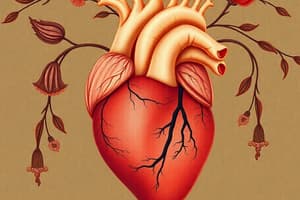Podcast
Questions and Answers
During which phase of the cardiac cycle do the atria contract following depolarization?
During which phase of the cardiac cycle do the atria contract following depolarization?
- Ventricular diastole
- Atrial diastole
- Ventricular systole
- Atrial systole (correct)
What happens to the semilunar valves during ventricular systole?
What happens to the semilunar valves during ventricular systole?
- They remain unchanged
- They open (correct)
- They close
- They partially open
What is the role of the end diastolic volume (EDV) in the cardiac cycle?
What is the role of the end diastolic volume (EDV) in the cardiac cycle?
- It is the volume of blood flowing back into the atria
- It is the volume of blood pushed out by the ventricles
- It is the volume of blood in the ventricles before contraction (correct)
- It is the volume of blood left in the ventricles after contraction
Which phase signifies the relaxation of the ventricles, indicated by the T wave?
Which phase signifies the relaxation of the ventricles, indicated by the T wave?
What defines the stroke volume in the cardiac cycle?
What defines the stroke volume in the cardiac cycle?
What characterizes the end systolic volume (ESV) in the cardiac cycle?
What characterizes the end systolic volume (ESV) in the cardiac cycle?
Flashcards are hidden until you start studying
Study Notes
Cardiac Cycle
- The cardiac cycle begins at atrial contraction and ends with ventricular relaxation.
- The cardiac cycle consists of two main phases: systole and diastole.
- Systole is the phase where the heart pumps blood into circulation.
- Diastole is the phase where the heart chambers are relaxed and filling with blood.
Cardiac Cycle Phases
- The cardiac cycle starts with atria and ventricles relaxed, allowing blood to flow into atria and ventricles (70% - 80%).
- Semilunar valves are closed during this phase.
- Atrial systole occurs when the atria contract from the superior portion following depolarization (P wave), also known as the "atrial kick".
- Atrial diastole is the phase where the atrial muscles relax as the ventricles begin to contract.
- Ventricular systole is the phase where the blood in the ventricles is at the end diastolic volume (EDV) or preload, and it flows towards the atria, forcing the atrioventricular valves to close (isovolumic contraction).
- During ventricular systole, pressure increases, forcing the semilunar valves open.
- Ventricular diastole is the phase where the ventricles relax (T wave), and the semilunar valves close, while the atrioventricular valves are also closed (isovolumic ventricular relaxation phase).
- In the second phase of ventricular diastole, the atrioventricular valves open.
Key Cardiac Cycle Measurements
- Stroke volume is the amount of blood pushed out by the ventricles, normally 70-80 mL.
- End systolic volume (ESV) is the amount of blood left in the ventricles after the stroke volume is pushed out.
Studying That Suits You
Use AI to generate personalized quizzes and flashcards to suit your learning preferences.



